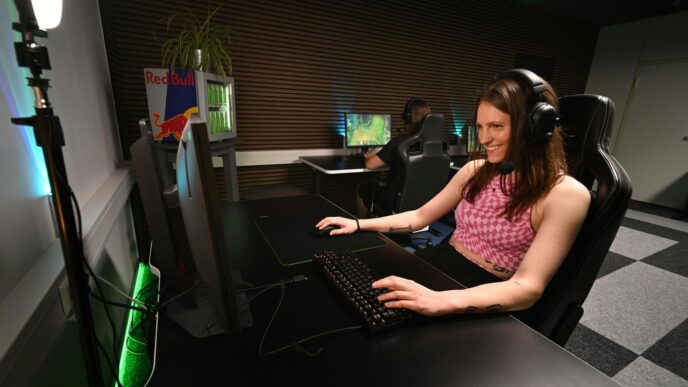Understanding the Role of VR Developers
To comprehend VR games’ intricacies, one must first recognize the pivotal role VR developers play. These professionals, often employed by a VR game development studio, are the architects of virtual worlds. They create the frameworks that transform raw code into engaging, interactive experiences. The demand to hire skilled VR developers has surged, reflecting the growing appetite for sophisticated, immersive gaming experiences.
VR developers are not just coders; they are artists who sculpt digital realms with precision and creativity. Their role requires a blend of technical and artistic skills, ensuring that each element of the game contributes to a cohesive whole. From designing complex algorithms to crafting stunning visuals, their expertise is crucial in delivering a seamless experience.
The journey of a VR developer is a continuous learning process. With technology evolving rapidly, developers must stay abreast of the latest advancements and trends. This involves regular training, attending industry conferences, and participating in workshops to hone their skills and push the boundaries of what VR can achieve.
Tools and Technologies
Central to VR game development is the use of advanced tools and technologies. Game engines like Unity and Unreal Engine have become industry standards, offering robust platforms for VR game development. These engines provide developers with the necessary tools to craft intricate environments and complex interactions, allowing for a seamless transition from imagination to digital reality.
Unity and Unreal Engine are not just tools; they are ecosystems that foster creativity and innovation. With extensive libraries, plugins, and community support, developers can access a wealth of resources to enhance their projects. These engines also facilitate cross-platform development, enabling games to reach a broader audience regardless of the hardware they own.
In addition to game engines, VR-specific software development kits (SDKs) are crucial. These kits, provided by hardware manufacturers like Oculus, HTC, and Valve, allow developers to optimize their games for specific VR headsets, ensuring compatibility and enhancing user experience. SDKs often include features such as spatial tracking, hand gestures, and voice recognition, adding depth to the interaction.
The Creative Process: From Concept to Execution
Creating a VR game is akin to directing a film, where every detail matters. It begins with a concept, an idea that sparks the imagination and sets the tone for the entire project. This concept is then fleshed out into a storyboard, detailing every scene and interaction the player will experience.
The execution phase involves meticulous planning and collaboration among a team of experts, including artists, programmers, sound designers, and writers. Each team member contributes their unique skills to build a cohesive and immersive world. Regular testing and iteration are crucial, allowing developers to refine gameplay mechanics and fix any bugs that may arise.
The final step is optimization, ensuring the game runs smoothly across different devices. This involves fine-tuning graphics, reducing latency, and enhancing load times to provide a seamless experience for players. Once the game is polished and ready, it is launched, marking the culmination of months, or even years, of hard work.
Crafting Immersive Experiences
Creating a Realistic Virtual World
At the heart of VR game development is the creation of immersive environments that captivate players. This requires an acute attention to detail and a deep understanding of spatial awareness and environmental storytelling. Developers must carefully design every aspect of the virtual world, from the textures and lighting to the physics and soundscapes, to ensure a cohesive and engaging experience.
The challenge lies in balancing realism with performance. While high-fidelity graphics are desirable, they must be optimized to run smoothly on VR hardware, which often has limited processing power compared to traditional gaming systems. Developers must find innovative solutions to maintain visual quality without compromising performance.
Environmental storytelling is a powerful tool in VR games. It allows players to uncover the narrative through exploration, piecing together the story from visual cues and subtle hints embedded in the environment. This technique enhances immersion, making players feel like active participants in the unfolding story.
Sound design plays a crucial role in creating a believable virtual world. From ambient noises to dynamic soundscapes, audio elements must be carefully crafted to enhance the sense of presence. 3D audio technology allows sounds to be positioned in space, giving players a realistic auditory experience that complements the visual elements.
Interaction and User Engagement
A key aspect that distinguishes VR games from traditional games is the level of interaction they offer. In VR, players are not mere observers; they are active participants in the game world. This requires developers to design intuitive control schemes that allow players to interact naturally with their environment.
Innovative input devices, such as motion controllers and haptic feedback systems, enhance this interaction, providing tactile feedback that adds a layer of realism to the experience. The integration of these devices into VR games represents a significant leap forward in user engagement, allowing players to physically interact with objects and characters within the game.
Creating intuitive interactions involves understanding human behavior and ergonomics. Developers must design control schemes that are easy to learn yet deep enough to provide a rich experience. This often involves prototyping and testing different interaction models to find the most natural and engaging approach.
Haptic feedback technology has transformed the way players engage with virtual worlds. By simulating the sense of touch, it allows players to feel the texture of objects, the impact of actions, and the presence of other characters. This level of feedback enhances immersion, making players feel like they are truly part of the game world.
Enhancing Immersion with Advanced Technologies
Advanced technologies, such as eye-tracking and full-body motion capture, are pushing the boundaries of VR interaction. Eye-tracking allows games to respond to the player’s gaze, enabling more natural and intuitive interactions. This technology can be used to focus on specific elements, enhance storytelling, and even adapt gameplay based on the player’s attention.
Full-body motion capture enables players to use their entire body as a controller, providing a more immersive and physically engaging experience. By tracking movements in real-time, games can replicate the player’s actions within the virtual world, allowing for more dynamic and responsive gameplay. This technology is particularly effective in fitness games, where physical activity is a core component.
Artificial intelligence (AI) is also playing a significant role in enhancing immersion. AI-driven characters can adapt to the player’s actions, providing a more personalized and engaging experience. Whether it’s a dynamic NPC responding to player choices or an adaptive environment that changes based on the player’s behavior, AI adds depth and complexity to VR games.
The Evolution and Impact of VR Games
Historical Context and Technological Advancements
The journey of VR games is one of constant evolution, driven by technological advancements and creative ambition. From the rudimentary virtual experiences of the late 20th century to the highly sophisticated games of today, VR has come a long way. This evolution has been fueled by improvements in hardware, software, and an ever-growing understanding of how to engage users in a virtual space.
The early days of VR were marked by experimentation and exploration. Developers were pioneers, testing the limits of technology to create immersive experiences. These early efforts laid the groundwork for the sophisticated VR games we see today, with each advancement building on the successes and failures of the past.
As technology progressed, so did the possibilities for VR. Improved graphics, faster processing speeds, and more accurate motion tracking have enabled developers to create more complex and immersive experiences. Innovations such as wireless headsets and room-scale VR have further expanded the potential of the medium, allowing for greater freedom of movement and interaction.
The impact of VR games extends beyond entertainment. They have found applications in various fields, including education, healthcare, and training, where immersive simulations provide valuable learning experiences. By offering a safe and controlled environment, VR can simulate real-world scenarios, allowing users to practice and learn without the risks associated with real-life situations.
The Future of VR Gaming
The future of VR gaming is bright, with continuous advancements on the horizon. Emerging technologies, such as augmented reality (AR) and mixed reality (MR), promise to further blur the lines between the virtual and real worlds, offering even more immersive experiences.
AR and MR are set to revolutionize the way we interact with digital content. By overlaying virtual elements onto the real world, these technologies create a seamless blend of the physical and digital, opening up new possibilities for gaming and beyond. Imagine playing a game where virtual characters interact with real-world objects, or participating in collaborative experiences with players from around the globe.
Moreover, the increasing accessibility of VR hardware and the growing talent pool of VR developers will likely lead to a surge in innovative games that push the boundaries of what is possible in virtual reality. As VR becomes more mainstream, we can expect to see a wider variety of games, catering to different tastes and preferences.
Social VR is another area poised for growth. As more people embrace virtual reality, the potential for social interactions within virtual worlds expands. Whether it’s attending virtual concerts, exploring digital art galleries, or simply hanging out with friends in a virtual space, social VR offers new ways to connect and interact.
Challenges and Opportunities in the VR Industry
Despite the promising future, the VR industry faces several challenges. One of the primary hurdles is the cost of VR hardware, which can be prohibitive for some consumers. As technology advances, reducing production costs and increasing affordability will be crucial to expanding the market.
Another challenge is the issue of motion sickness, which can affect players’ enjoyment and comfort. Developers are continually working on techniques to minimize motion sickness, such as optimizing frame rates, improving head tracking, and designing comfortable locomotion systems.
On the flip side, the VR industry presents numerous opportunities for innovation and growth. As more industries recognize the potential of VR, there is a growing demand for content that caters to different sectors, such as education, healthcare, and tourism. This diversification allows developers to explore new avenues and create unique experiences tailored to specific audiences.
Engaging the Gaming Community
Fostering Interaction and Debate
A vibrant gaming community surrounds VR games, with developers, gamers, and critics engaging in lively discussions about the future of the medium. These debates often focus on topics such as the ethical implications of VR, the potential for addiction, and the balance between realism and artistic expression.
Engagement within the community is crucial for driving innovation and improvement. Developers can gain valuable insights from player feedback, allowing them to refine and enhance their games. Community forums, social media platforms, and gaming conventions provide spaces for these interactions, fostering a collaborative environment where ideas can flourish.
For game developers and content creators, engaging with this community is crucial. By participating in discussions and sharing insights into the development process, they can foster a deeper understanding of VR games and inspire future innovations. Transparency and open communication help build trust and loyalty among players, encouraging long-term engagement.
The community also plays a role in shaping the direction of VR development. As players express their preferences and concerns, developers can adapt their strategies to align with the community’s expectations. This feedback loop ensures that VR games continue to evolve in ways that resonate with players, keeping the medium fresh and exciting.
The Role of Content Strategy
For content strategy managers at gaming companies, providing high-quality, engaging content about VR games is essential. This involves crafting articles, videos, and other media that delve into the complexities of VR game development, sparking interest and discussion among the audience.
Effective content strategy goes beyond marketing; it’s about educating and engaging the audience. By producing insightful content that explores the nuances of VR technology and game design, a leading VR game development company can position themselves as thought leaders in the industry. This not only attracts potential customers but also builds credibility and trust.
By leveraging the expertise of seasoned VR developers and journalists, these managers can create content that not only informs but also captivates the gaming community, encouraging interaction and fostering a sense of belonging among players. Interactive content, such as behind-the-scenes videos, developer interviews, and interactive demos, can further enhance engagement and provide a deeper understanding of the creative process.
In addition to creating content, content strategists must also focus on distribution. Identifying the right platforms and channels to reach the target audience is crucial for maximizing impact. Whether it’s through social media, blogs, or video-sharing sites, effective distribution ensures that content reaches the right people at the right time.
Building a Community-Driven Ecosystem
Building a community-driven ecosystem involves creating spaces where players can connect, share, and collaborate. Online forums, Discord servers, and social media groups provide platforms for players to discuss their experiences, share tips, and organize events. These spaces foster a sense of community and belonging, enhancing player engagement and loyalty.
Community-driven initiatives, such as modding and user-generated content, allow players to contribute to the development of VR games. By providing tools and resources for players to create their own content, developers can tap into the creativity and passion of the community, resulting in a more diverse and vibrant gaming ecosystem.
Hosting events, such as tournaments, workshops, and developer Q&As, further strengthens the bond between developers and the community. These events provide opportunities for players to interact with developers, gain insights into the creative process, and celebrate their shared passion for VR gaming.
Conclusion
In conclusion, VR games represent a fascinating intersection of technology and creativity, offering immersive experiences that captivate players and push the boundaries of interactive entertainment. As the field continues to evolve, understanding the mechanics of VR game development and engaging with the gaming community will be vital for developers, journalists, and content strategists alike.
Whether you are looking to hire VR developers or simply wish to explore the intricacies of virtual reality games, the future promises exciting developments that will redefine the way we experience digital worlds. By staying informed and engaged, you can be at the forefront of this dynamic and rapidly changing industry.
The journey of VR gaming is far from over, with new horizons and possibilities awaiting exploration. As technology continues to advance and the community grows, the potential for innovation and creativity in VR gaming is limitless. Together, developers, players, and enthusiasts can shape the future of this exciting medium, creating experiences that transcend the boundaries of reality and imagination.














